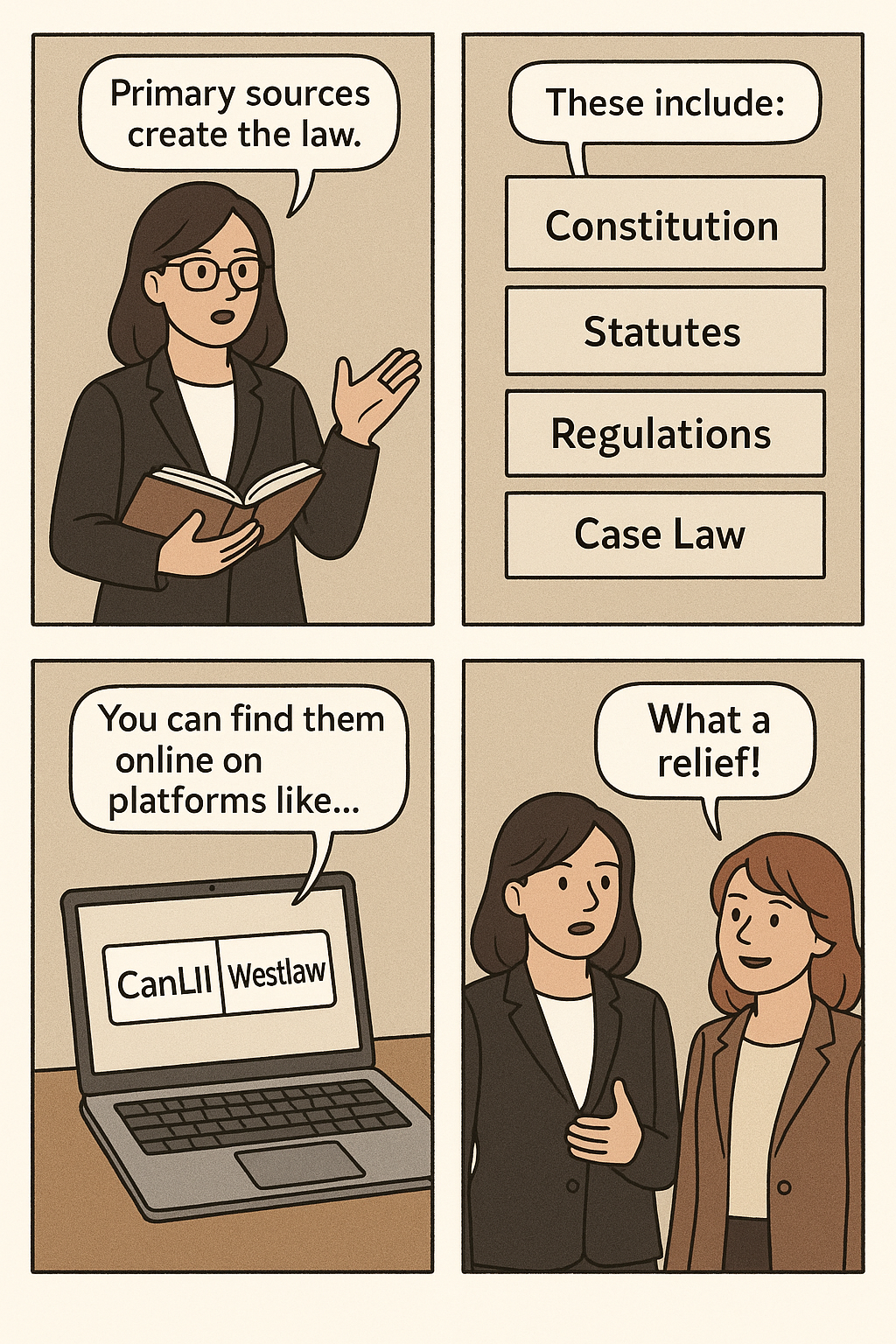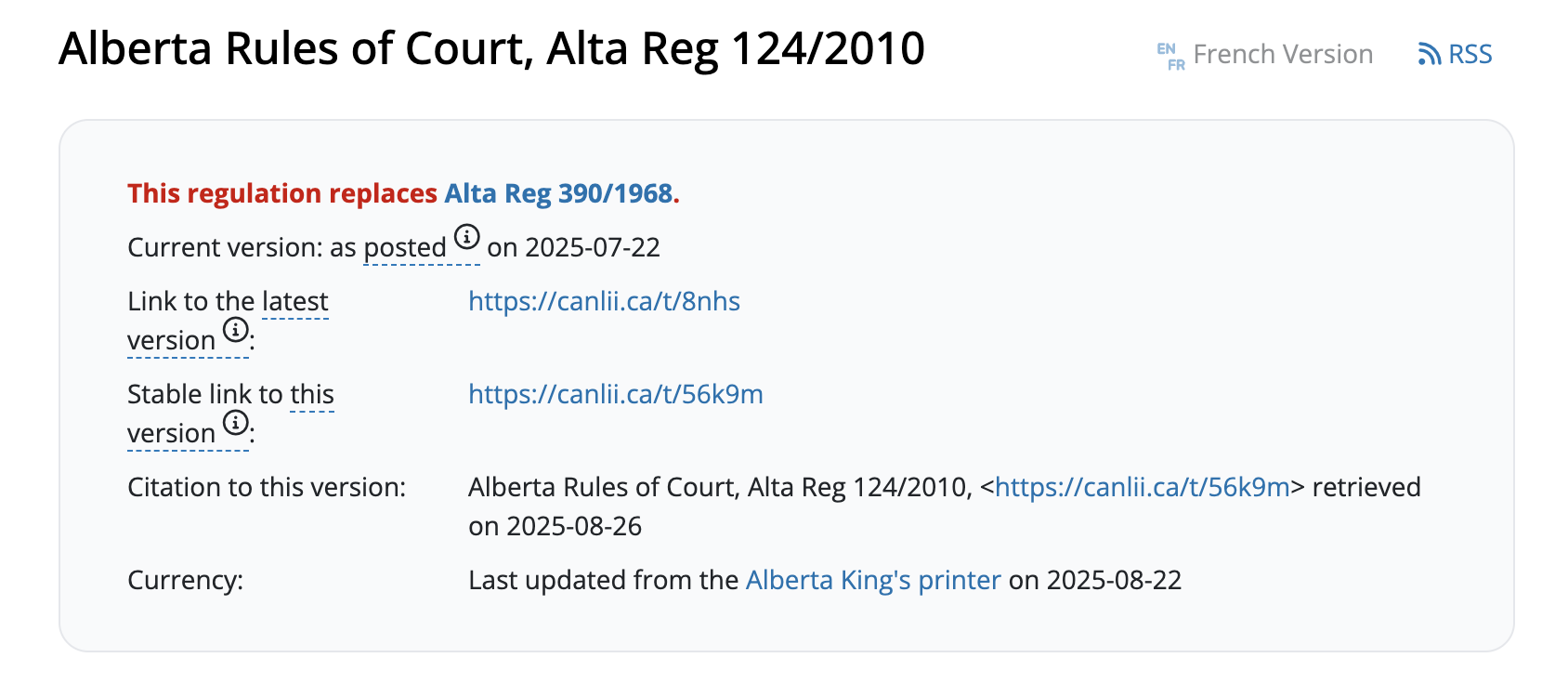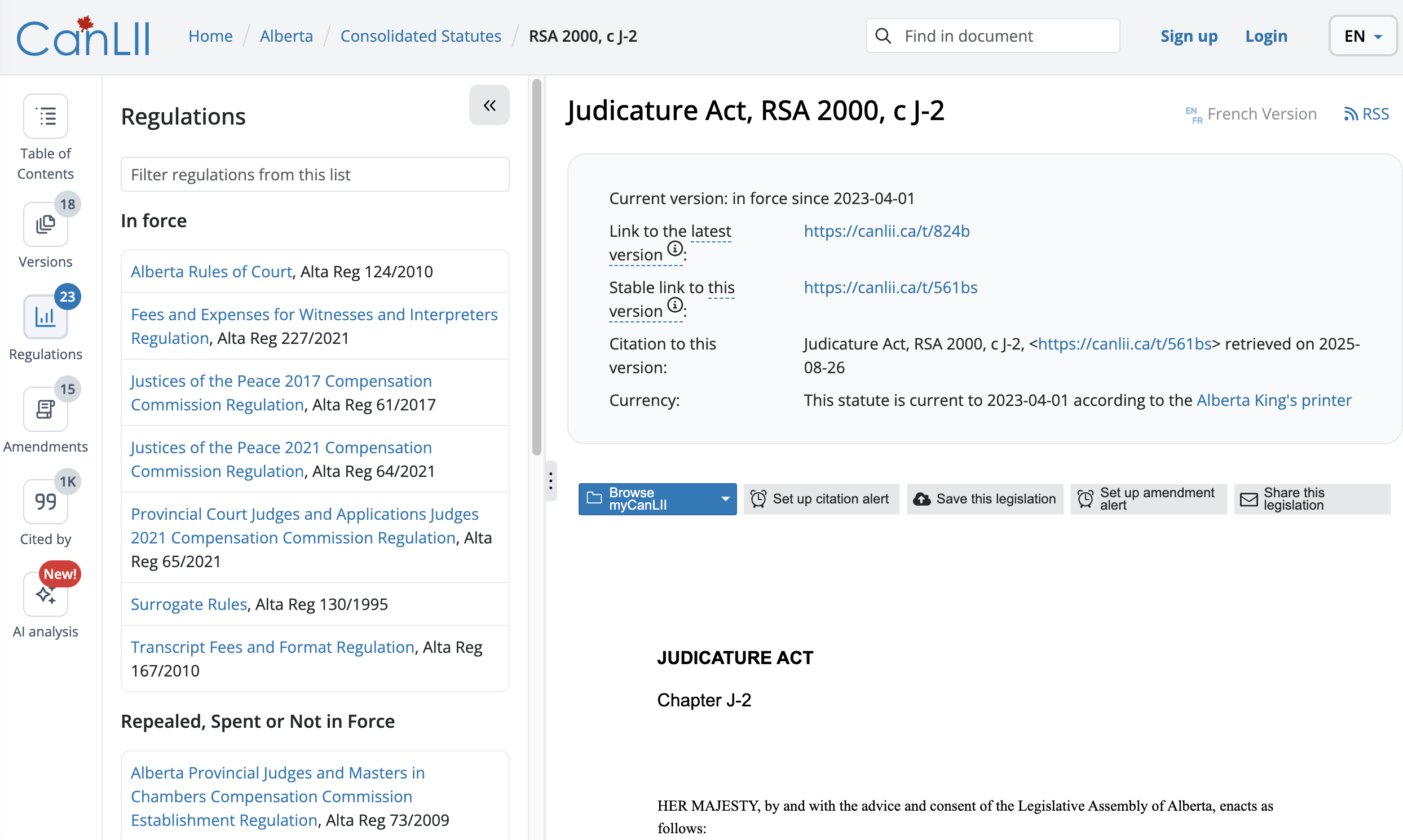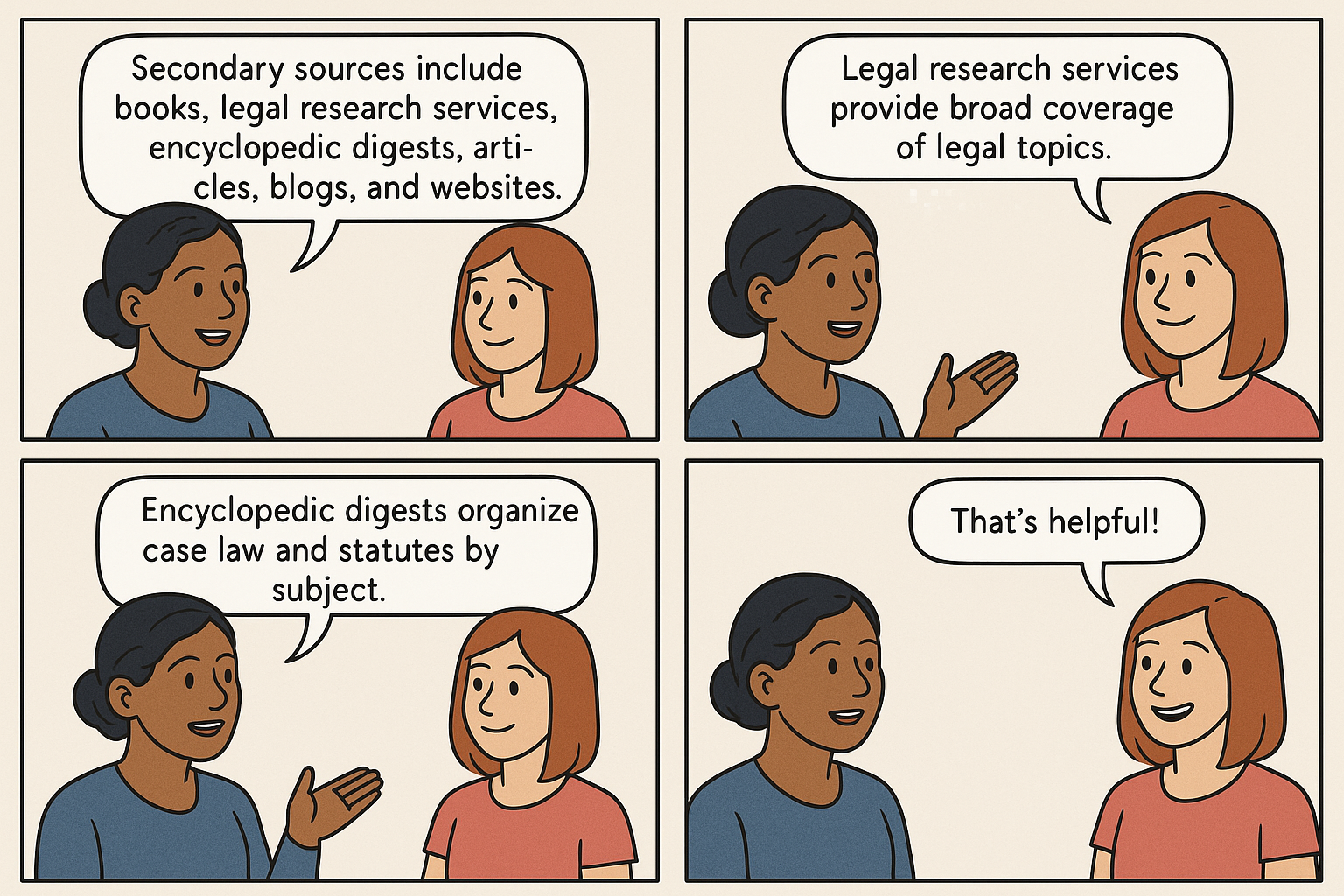Primary and Secondary Sources
Ashley McDonald and Kris Ravelo
Learning Objectives
Upon successful completion of this chapter, learners will be able to:
-
Identify different types of primary sources, including statutes, regulations, case law, and bylaws.
-
Explain the role of secondary sources in legal research and how they complement primary sources.
-
Locate primary and secondary sources using online legal research tools.
-
Apply strategies to use secondary sources effectively at different stages of legal research.
Introduction
Legal research relies on both primary and secondary sources of law. Primary sources, such as the Constitution, statutes, regulations, bylaws, and case law, form the foundation of Canada’s legal system and create binding authority. Secondary sources, including books, legal research services, digests, articles, and commentaries, provide context, interpretation, and analysis that help researchers understand, evaluate, and apply the law. This chapter introduces the major categories of primary and secondary sources, explains where they can be accessed, and outlines how to use them strategically at different stages of the research process. Although a small component, this chapter also emphasizes the importance of proper citation practices to ensure clarity, accuracy, and credibility in legal writing.
Primary Sources

A primary source is the first source from which the information comes, whether you have witnessed it or found it in case law, legislation, or government documents. Primary sources create the law and are heavily relied upon when conducting legal research (Blatt & Kurtz, 2020, p. 7).
Examples of primary sources are legislation, government documents, and jurisprudence (case law).
There are many online resources to find primary sources, such as CanLII and Westlaw/Lawsource. This is where you can find past legal precedents and decisions that are essential for conducting legal research.
Primary sources include:
- Statutes,
- Regulations,
- Bylaws, and
- Case Law.
These primary sources give legal researchers specific information they may need when conducting legal research. Each is important in its own way and, when used effectively, can improve the overall quality of the research. Which, in turn, will result in compelling evidence gathered regarding the presented legal issue.
Constitution
The Canadian Constitution is Canada’s highest law, and every law must be consistent with the Constitution (Fitzgerald, 2016, p. 38). The Constitution outlines “who can make laws, who will enforce the laws, and who interprets the laws” (Fitzgerald, 2016, p. 39). Sections 91 and 92 of the Constitution establish a separation of powers between the Federal and Provincial governments.
The Federal government’s powers are established in section 91 of the Constitution, which includes matters of national interest that include national defence, currency, and criminal law (Government of Canada, 2021).
The provincial government’s powers are established in section 92 of the Constitution, which includes prisons and education administration of Civil/Criminal Justice (Government of Canada, 2021).
Every law created falls below the Constitution and must be consistent with the highest law in Canada to be considered a valid law.
Note: Visit the Department of Canadian Heritage website to view, download, or order the Canadian Charter of Rights and Freedoms and the Canadian Bill of Rights.
Legislation
Legislation, also called Statutes or Acts, is created by the Canadian Parliament or through a Provincial Legislature (Blatt & Kurtz, 2020, p.14). They set out the law about a matter, state the method of doing or not doing things, and set out penalties if someone does something prohibited (Blatt & Kurtz, 2020, p. 14). The chart below provides a brief overview of the similarities between the legislative processes at the federal and provincial levels.
| Federal Statutes | Provincial Statutes |
|
|
Accessing statutes is a critical step in legal research because it requires the researcher to first determine the correct jurisdiction and whether the issue falls under provincial or federal legislation. Identifying the proper jurisdiction ensures that the correct body of law is being applied. Once jurisdiction is established, the researcher must locate the specific statute that governs the client’s legal issue, as this will provide the applicable law for the matter.
Once a statute comes into force, it is available online and in print format. Every statute created in a particular year for both Parliament and the Provincial Legislature is collected and compiled into a series for that specific year (Blatt & Kurtz, 2020, p. 16). Each series gives the statutes a chapter number in the order they were passed during that year.
The Alberta King’s Printer allows for ordering printed materials if a physical copy of a statute or legislation is required. There is a fee associated with ordering physical copies of materials, but online materials are available for free.
The materials posted to legal platforms (like CanLII, for example) are pulled from the Alberta King’s Printer (in Alberta) or the corresponding province where the legislation was created. For federal matters, legal research platforms pull information from the Justice Laws Website.

In Canada, laws must be made publicly accessible so that citizens are aware of the rules they are required to follow. This principle of transparency is essential to the rule of law: individuals cannot be expected to comply with laws that are hidden or unavailable. To fulfill this obligation, governments publish legislation and regulations through official sources such as the Canada Gazette and the Alberta Gazette. In addition, open-access platforms like CanLII provide free online access to statutes, regulations, and case law, ensuring that both legal professionals and the public can consult the law. These resources reflect the democratic principle that the law must be known and accessible in order to be effective.
Regulations
Regulations are the “rules made under the authority of an enabling statute” (Blatt & Kurtz, 2020, p. 34). The regulations establish how the enabling statute should be carried out and what the overall purpose of the statute is. The enabling statute also authorizes who is allowed to create the regulations; this can be ministry officials, departments, or the governor in council (p. 34).
Like statutes, regulations are available in both print and online formats. A physical copy of the regulations can be ordered from the Alberta King’s Printer for a fee or found online through legal databases, such as CanLII and Westlaw. When searching the legal databases, regulations can be searched on their own, or they can be found connected to each statute on a separate tab titled “Regulations” when looking at the specific statute.
For example, the Alberta Rules of Court is one regulation of many, with the overarching statute, the Judicature Act. See the list of regulations under the Judicature Act in the image below.

The regulations contain the rules that authorize the statute, state what actions are permitted, required, and prohibited, and also describe penalties when a prohibited act is committed (Blatt & Kurtz, 2020, p. 35). This is why it is essential to review the regulations in addition to the overarching statute in your legal research process.
Government Documents: Parliamentary and Non-Parliamentary Documents
According to the University of Calgary (2024), official publications of government documents can be divided into parliamentary and non-parliamentary papers. Parliament uses parliamentary papers to conduct its everyday business, and the Members of Parliament use them as well as their staff and the public. These papers are a permanent record of the business conducted in Parliament, such as debates and decisions made, and can be used to follow Parliament and its day-to-day business.
- Parliamentary papers include committee documents, journals, minutes of proceedings, and bills.
- Non-parliamentary papers are any papers a government department produces intended for use outside of Parliament.
These papers can be found electronically on the House of Commons website and are helpful when conducting legal research, as they allow you to see what information is being discussed in Parliament and bills proposed to the House of Commons. This information may be crucial to the legal issue at hand, especially if a proposed bill could change the law that applies to your client’s situation.
Bylaws
Bylaws are laws created by a municipal government, and they are delegated this power by the provincial legislature (Blatt & Kurtz, 2020, p. 28). Municipal governments can create bylaws for business licensing, structures, animals, health, and safety (p. 28).
Most municipalities will have their bylaws on a database that the public can search; however, if the bylaw cannot be located, then it is recommended to contact the municipality office for a paper version of the most recent bylaw that pertains to the legal research (Blatt & Kurtz, 2020, p. 29).
Linked below are the websites for Edmonton and Calgary’s bylaws.
Case Law
Researching case law is a crucial part of legal research. Case law, also known as jurisprudence, is the decisions that judges make regarding a legal proceeding (Blatt & Kurtz, 2020, p. 44). The decision maker hears both sides of a case, where the opposing parties present evidence and arguments regarding the facts of the legal matter. After hearing both sides, the decision maker will favour one of the presenting parties (p. 45).
Case law is beneficial if the facts and issues in the case are similar to those of your client matter, as this allows you to determine the probable outcome if the case proceeds, what evidence needs to be presented, and what the client may be awarded in damages (Blatt & Kurtz, 2020, p. 45). Cases that are similar to your legal issue are called “analogous cases”.
When researching cases, it is important to pay attention to the jurisdiction where the case is decided, as this will determine if it is binding or persuasive. When a case is binding, the court must follow the decision made by the judge of a higher-level court (vertical stare decisis). Although exceptions apply and horizontal stare decisis is also applicable, its complexity extends outside the scope of this chapter (Blatt & Kurtz, 2020, p. 45). The concept of stare decisis is elaborated further in another chapter of this textbook.
Secondary Sources

As an essential tool in legal research, secondary sources provide analysis and insight into primary sources of law. The thoroughness and efficiency of legal research can be significantly enhanced by understanding how to navigate and use secondary sources effectively. Unlike primary sources, secondary sources discuss information first presented elsewhere. Secondary sources are also important as they represent another interpretation of a primary source (Byellin, n.d). In other words, if you are researching a legal issue or area of law that you are unfamiliar with, it is helpful for you to first review secondary sources to review the interpretation of the law, before reviewing the primary sources.
While secondary sources are invaluable research tools, they should not be cited as a binding authority for legal research purposes, but are helpful – and often found in a List of Authorities – in assisting with the interpretation of primary law. Always verify and cite the primary sources referenced by secondary sources. Examples of Secondary Sources are: legal treatises, legal-specific encyclopedias, dictionaries, journals, periodicals, commentaries, or articles.
To find Secondary Sources, there are many online resources such as articles, commentaries, legal databases, and digests linked in CanLII and Westlaw (Pobojewski, 2019). These secondary sources are often found in the “commentaries” sections of legal research platforms.
Secondary sources include books, legal research services, encyclopedic digests, articles, blogs, and websites, as outlined in the Canadian Guide to Uniform Legal Citation. Legal research services such as Thomson Reuters Canada and LexisNexis provide broad coverage of legal topics, while encyclopedic digests like the Canadian Encyclopedic Digest (CED) organize case law and statutes by subject, making them an excellent starting point for unfamiliar areas of law. Articles often provide commentary or critical analysis and may include a DOI, while blogs and websites can also offer valuable insights and up-to-date information.
Finding and Using Relevant Material
When it comes to finding and using relevant material, we normally take a look at legal commentary, which includes secondary sources, some of which were mentioned above. These resources offer in-depth analysis and interpretation of legislation and judicial decisions.
Throughout Canada, there are multiple online legal databases that are the best way to interpret legislation, one of the best ways to find what is relevant is by “noting up” the legislation; this is sometimes referred to as “finding judicial consideration” of a statute or regulation, which involves the process of finding cases that have been applied or discussed based on a particular statute, regulation or section of either. (LibGuides: Research 101: How to Note-Up Statutes and Regulations: Home, n.d.-b).
Another way of finding and using relevant materials is through sources that legal databases provide, such as Westlaw Canada and LexisNexis; these databases provide a space for the most thorough search of relevant materials, which offer comprehensive access to case law, secondary materials, and tools for legal research. Additionally, CanLII is another source for Canadian case law and other precedents for interpreting legislation.
Additionally, it is important to take a look at the Annotated Statutes, Words and Phrasing, and Digests that are available.
Words and Phrases are sets that have been judicially interpreted or that have been legally defined in court and administrative decisions, they show the context in how they have been judicially defined by including, relevant excerpts from the decision, and case citations. (Research guides: Law – beginning your research: Words & phrases). These are found on Westlaw, under ‘Finding Tools’.
Digests are based on case law and are collections of case summaries that are organized by hierarchical subject classification. They offer a comprehensive overview of the principles throughout different legal subjects. While digests are based on case law, they do not contain all cases on a topic, and they cannot keep pace with the release of new decisions. However, they are a useful starting point that highlight the most significant cases or statutes. (Libguides: Legal Research and writing: Legal encyclopedias and digests). There are two main digests used in Canada, which are the legal encyclopedias and the Canadian Abridgment Digests; both can be found on Westlaw and LexisNexis.
Using Secondary Sources to Locate Primary Sources
Secondary sources serve as a useful tool in finding primary sources by providing citations to relevant cases, statutes, and regulations. Often, secondary sources will identify leading cases in specific areas of law and offer cross-references to related legal topics. Many secondary sources will separate relevant points of law from referenced primary sources, potentially saving a lot of time and energy in the early stages of the research process (Byellin, n.d.).
It is always preferable to cite directly to the original source where possible. Consult specific source sections for the original/authoritative source for document type, as the original source varies by type (i.e., legislation, jurisprudence, etc.).
Using Secondary Sources for Background Information
Throughout the research process, secondary sources can be used strategically to increase efficiency and further understanding. Secondary sources can be used to explain primary sources, supporting a more comprehensive understanding by discussing, analyzing, or restating primary sources (Byellin, n.d.). Using secondary sources to provide context typically results in a more complete understanding of the law itself. Additionally, using secondary sources expands one’s perspective with diverse interpretations and analyses of the law (Byellin, n.d.).
Secondary sources are strategically useful at different stages of legal research. At the beginning of the research process, they help grasp fundamental legal principles, understand complex concepts, gain an overview of a topic, identify key terms, and develop a research plan. They are also valuable for evaluating key issues and arguments. When updating research, secondary sources can track recent developments, highlight emerging trends, and point to new primary sources.
A Note on Citing Legal Sources
Accuracy and consistency in citations are essential in legal writing. To properly inform the Court or a supervising lawyer, references to primary or secondary sources must be correct and cited in a way that directs the reader to an open-source platform. This ensures that the source of information can be reliably tracked (University of Alberta, 2024).
The Canadian Guide to Uniform Legal Citation, commonly known as the McGill Guide, is the standard guide to legal citation. This resource is expensive, and some firms may have a subscription that allows you to access this excellent resource. The University of Alberta and Queen’s University have essential guides that follow legal citation according to the most recent edition of the McGill Guide.
- U of A Library’s McGill QuickGuide
- Queen’s University Library’s Legal Citation with the 10th edition of the McGill Guide
However, if you do not have access to the McGill Guide, there are open-access platforms that are excellent resources to use when citing legal sources. The Canadian Open Access Legal Citation Guide is a citation guide that is accessible to everyone via an open-access publishing model. Discussion of legal citation is outside the scope of this text, and we encourage you to learn more about legal citation by reviewing the Open Access Legal Citation Guide directly.
Summary
Primary sources form the basis of Canadian law and include the Constitution, statutes, regulations, bylaws, and case law. These sources establish legal rules and provide binding authority that legal professionals must follow. Secondary sources, such as books, digests, research services, and articles, interpret and analyze primary sources, making them valuable tools for understanding complex legal issues and identifying relevant cases or legislation. Using secondary sources strategically can help researchers begin their work, refine their focus, and update findings with recent developments. Both primary and secondary sources are accessed through official government publications and online databases like CanLII, Westlaw, and LexisNexis. Finally, accuracy in legal citation is crucial to maintaining professional credibility, ensuring transparency, and enabling readers to track the sources relied upon in legal research and writing.
Reflection Questions
-
Why is it important for primary sources to be publicly accessible in a democratic society?
-
How can secondary sources save time and improve efficiency when beginning legal research?
-
What risks might arise if a researcher relies only on secondary sources without verifying the primary sources?
-
How does understanding the separation of powers in the Constitution affect legal research?
-
In your view, which type of secondary source (articles, digests, legal research services, etc.) is most helpful to a new researcher, and why?
References
Blatt, A. & Kurtz, J. (2020). Legal research: Step by step (5th ed.). Emond Publishing.
Byellin, J. (n.d.). The basics of secondary sources – what, why, how. Thomson Reuters. Retrieved March 31, 2025, from https://legal.thomsonreuters.com/en/insights/articles/the-basics-of-secondary-sources-what-why-how
Fitzgerald, M. F. (2016). Legal problem solving: Reasoning, research and writing (7th ed.). LexisNexis Canada.
Ellis, M. (2022, September 26). How to write an outline in 5 steps. Grammarly. Retrieved March 25, 2025, from https://web.archive.org/web/20250116143611/https://www.grammarly.com/blog/writing-process/how-to-write-outline/ (archived version)
Government of Canada. (2021, October 5). The constitutional distribution of legislative powers. Retrieved March 23, 2025, from https://www.canada.ca/en/intergovernmental-affairs/services/federation/distribution-legislative-powers.html
Grammarly. (2023, October 27). How to edit a paper: Step-by-step guide & examples. Retrieved April 1, 2025, from https://www.grammarly.com/blog/writing-process/editing/
Great Guides. (2024, January 18). Research 101: How to note-up statutes and regulations. Retrieved June 19, 2025, from https://web.archive.org/web/20240120112530/https://greatguides.lso.ca/101noteuplegislation (archived version)
McCarney, M., Kuras, R., Demers, A., & Kierstead, S. (2016). The comprehensive guide to legal research writing & analysis (2nd ed.). Emond Publishing.
Pobojewski, A. (2019, April). Secondary sources: Understanding what they are, why they are important, and how they can benefit your practice. LexisNexis. Retrieved March 31, 2025, from https://www.lexisnexis.ca/en-ca/mll/law-librarian-news/2019-04/secondary-sources-understanding-what-they-are-why-they-are-important-and-how-they-can-benefit-your-practice.page
Thomson Reuters. (n.d.) Search the Canadian Encyclopedic Digest. Retrieved March 24, 2025, from https://www.thomsonreuters.com/en-ca/help/westlaw-edge/secondary-sources/search-canadian-encyclopedic-digest
University of Alberta Library. (2024, February). McGill citation style quickguide (10th ed.). Retrieved March 24, 2024, from https://guides.library.ualberta.ca/ld.php?content_id=37048208
University of British Columbia Library. (n.d.) Law – Beginning your research: Words & phrases. Retrieved June 19, 2025, from https://guides.library.ubc.ca/beginlegal/wp
University of Calgary. (2024, September 3). GOVINFO: Canadian parliamentary (legislative) publications. Retrieved March 24, 2025, from https://libguides.ucalgary.ca/guides/govcanparl#s-lg-box-5198782
University of Victoria. (n.d.) Legal research and writing: Legal encyclopedias and digests. Retrieved June 19, 2025, from https://libguides.uvic.ca/lrw/encyclopedias-digests
The process of finding cases that have been applied or discussed based on a particular statute, regulation or section of either.

